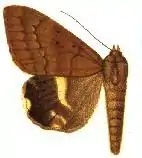Achaea catocaloides
Achaea catocaloides is a species of moth of the family Erebidae first described by Achille Guenée in 1852. It is found in Liberia, Guinea, Benin, Dahomey, Ivory Coast, Kenya and Uganda.[1]
| Achaea catocaloides | |
|---|---|
 | |
| Scientific classification | |
| Kingdom: | Animalia |
| Phylum: | Arthropoda |
| Class: | Insecta |
| Order: | Lepidoptera |
| Superfamily: | Noctuoidea |
| Family: | Erebidae |
| Genus: | Achaea |
| Species: | A. catocaloides |
| Binomial name | |
| Achaea catocaloides Guenée, 1852 | |
| Synonyms | |
| |
There are up to two generations per year.
In December 2008 and January 2009, there was a serious outbreak of in the border region of Liberia and Guinea, causing the Liberian government to declare a state of emergency. The feces of the caterpillars made local streams undrinkable.[2]
The larvae normally feed on various trees, but can become a pest on agricultural crops like coffee, cocoa, citrus, plantain, banana and cassava.
The larvae, known as minsangula or lukunku in D.R. Congo and mindelemoka or muchangumuna in Congo Republic, are eaten and frequently sold in markets.[3]
References
- De Prins, J. & De Prins, W. (2019). "Achaea catocaloides Guenée, 1852". Afromoths. Retrieved December 15, 2019.
- Lange, Karen (February 5, 2009). "Nightmarish Caterpillar Swarm Defies Control in Liberia". National Geographic News. Archived January 17, 2017.
- Latham, Paul (2015). "Edible caterpillars and their food plants in Bas-Congo province, Democratic Republic of Congo". Researchgate. Retrieved 3 July 2020.